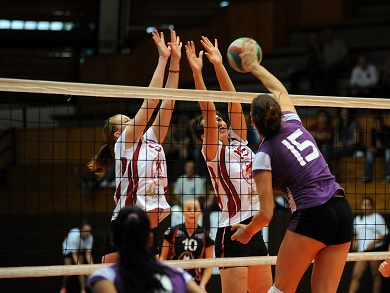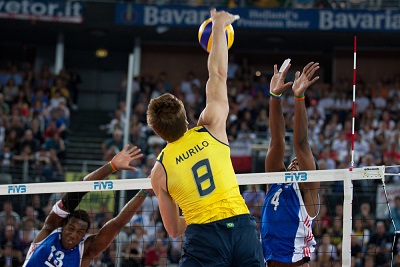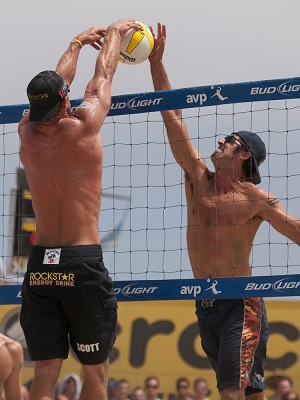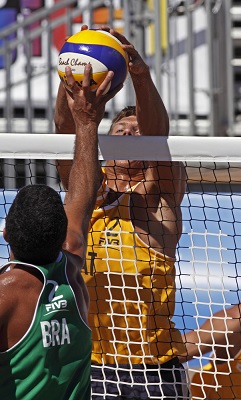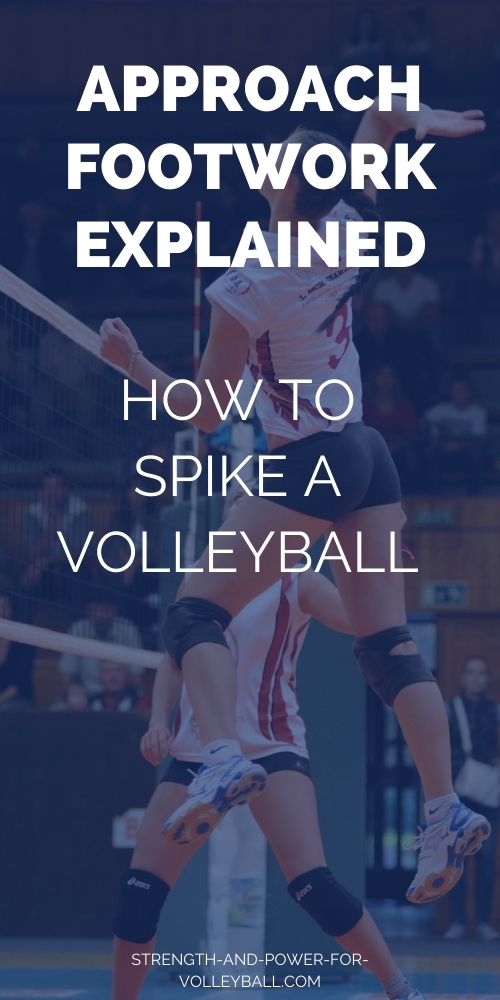How to Spike a Volleyball
Important Tips for Better Attacks
Could you use some tips on how to spike a volleyball?
Every approach and armswing should look exactly like the last one.
Be Deceptive.
Any deviation in your approach and armswing will send clues to the defense about what you're going to do.
The longer you wait to decide what you're going to do (for example, tip
to the middle instead of swing hard) the harder it will be for the
defense to read your hit.
It's only at the very last moment as you are about to contact the ball that you decide what to do.
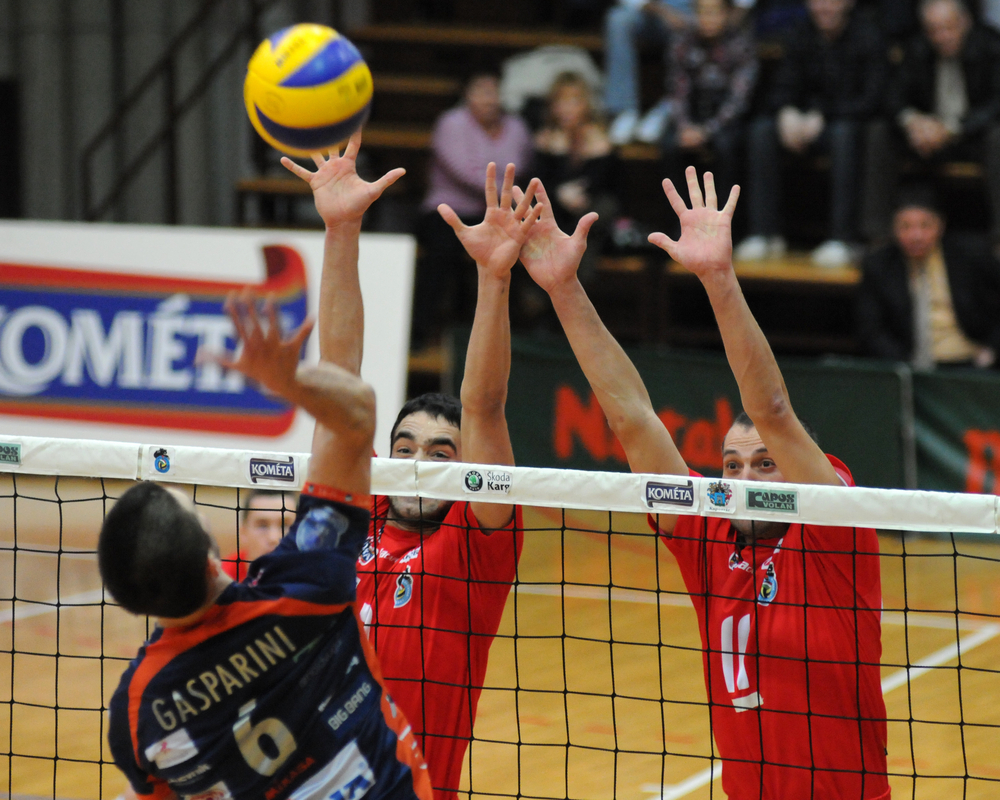
Taking a Good Approach and Armswing
Also remember to jump high every single time you approach. This will make
the defense think you're going to swing hard every time.
Broad Jumping vs Jumping Straight Up
Which is better for hitting?
Taking a big approach, flying in and broad jumping to the ball...
or
Taking a big approach, getting underneath the ball, and jumping more straight up?
Hitting a Smart Shot Off the Blocker
Some advantages of the broad jump...
1. You can hit hard. All coaches would like to have their players hit harder. If you hit hard, it's harder
for the defense to block and dig.
Also, broad jumping
into the ball can give you a lot of momentum and allow you to put more energy into the ball.
2. You can be hard to read. Players that broad jump tend to just focus
on hitting the ball as hard as they can. They aren't so concerned about placing
the ball. If you have a fast arm swing and you hit the ball flat, it's often
harder to read and dig this type of attack.
Some disadvantages to the broad jump...
1. If you broad jump, you have less options for hitting. For example, if
you broad jump, you're flying in and it's harder to hit the ball at a downward
angle into the court. You can get to the ball, but your options for what to do
with it are limited.
2. You have a smaller window. Players that broad jump tend to have a smaller window because it's hard for them
to hit a tight set. Players that broad jump don't like tight
sets because they'll end up landing in the net or on a blocker. And it's tough
to hit around a blocker when the set is tight. Often their only option is to
tip because they must reach so far out in front to get to the ball. Not being able to hit a tight set allows your opponent
to make defensive plays more easily.
This
also puts pressure on the setter because if the set is too tight, the hitter's in trouble.
3. Contact usually isn't as good. Players that broad jump usually
focus more on just hitting the ball hard and not contacting the ball
with control. The ball is usually contacted more
flat without much topspin.
Some advantages to jumping more straight up...
1. More hitting options. When you approach and jump more straight up, you have more options for hitting. Since you're jumping up and not flying forward, you will contact the ball at a higher point. When you contact the ball higher, you have more options for hitting (more options for sending the ball into the court at different trajectories).
2. You can hit a tight set. There are many situations in volleyball where a player needs to be able to make a play on the ball in the plane of the net. Hitting a 50/50 ball, tipping a tight set around the block, and jousting with a blocker, are all important opportunities for winning a rally. The players ability to win the game at the net is often the difference between winning and losing.
Getting Up High and Reaching High to Hit
When it's good to broad jump...
1. When hitting a back row attack.
2. When the sets off the net.
When not to broad jump...
1. When the sets tight.
2. When you need to block or joust.
How to Spike a Volleyball by Developing an Arsenal of Hitting Options
The more options you display when you hit, the less predictable you become.
If you have only a couple hitting options, you are much more predictable and much easier for the defense to read.
Master the following hitting options and you'll become a much more deceptive attacker.
Swinging hard cross court. Probably the most common attack is a hard driven cross court hit. This hit is especially effective if the middle is
slow to get to the outside to block.
This attack can also be effective if your opponent is playing perimeter
defense because the setter will usually have to make the dig. If the
setter makes the play, you've taken the setter out of the offense.
Swinging hard down the line. A hard hit down the line is often
the most difficult ball to dig. If you're able to hit the ball hard down
the line, it will
be difficult to run an effective offense because the digger needs to
pass the ball at a tough angle. It's especially hard to pass the ball to
the setter when the right side hitter
attacks the ball down the line.
Tipping the ball to the middle. A tip to the middle of the court
is usually effective against a team playing perimeter defense.
Especially if you approach fast and jump high every time you approach,
you will likely
freeze the defense. Tipping to the middle isn't as effective against a
man-up defense or red defense because there's a defender behind the
block covering tips. So it's important to know what
defense your opponent is playing before you decide where to tip the
ball.
Tipping to zones 2 and 4. Middle hitters should develop the
ability to tip the ball to zones 2 and 4. Especially on tight sets,
tipping the ball just over the out stretched hands
of the block is very effective. Tipping to zones 2 and 4 is especially
effective against teams playing man-up or red defense because the
defensive player playing up behind the block usually will start in the
middle of the court behind the block.
Tipping the deep corners. Tipping to the corners can be difficult
to learn because it can often take a lot of strength to tip deep.
Tipping deep can be a
great weapon for outside hitters. It can become a guessing game whether
or not a defender should stay at the baseline or rotate over to defend
the tip/shot down the line.
Also, if you have the ability to tip deep then tipping short becomes
even more
effective.
Winning a Joust
You don't want to just learn how to spike a volleyball. Jousting is also an important skill.
It's not strength but leverage that wins a joust. To win the battle, you
want to keep your weight behind the ball. It's best to be under the
ball, not
on top.
The shorter player that gets behind the ball will usually beat out the bigger
player that puts her strength and hands over the ball.
If you can get your opponent on top of the ball with you underneath, you will usually win.
The player that reaches more forward than up will usually have better leverage
for winning the joust. You want to reach out, lock your arm and hold the ball
against the opposing blocker.
As you come down, push through the opponent so the
ball falls on their side of the net.
Winning a Joust on the Beach
In the above photo, it's going to be tough for the attacker to win the joust
because he has to reach so far to push the ball through the block. Also, the
blocker is making contact with the ball on the opponents side.
When blocking, your best chance of winning the battle will be if you penetrate
and play the ball right out of the opponents hand. As a blocker, always try to
make contact with the ball on the opponents side.
In the above situation, the
attackers best option is to push through the block or swipe the ball off the
hands.
Holding the Joust to Win
In the above photo, you can see how it can be important to jump close to the net.
For example, if you were to broad jump in this situation, you won't reach as
high and won't hang in the air as long.
You'll also probably land in the net or
on your opponent. So if you can see the ball is going to be set tight, be sure to take your last
steps close to the net, jumping more straight up.
If you enjoyed these tips and would like to keep it close to you at any time, just save this pin to your Pinterest Volleyball Training Board.
Volleyball › How to Play Volleyball › How to Spike a Volleyball
